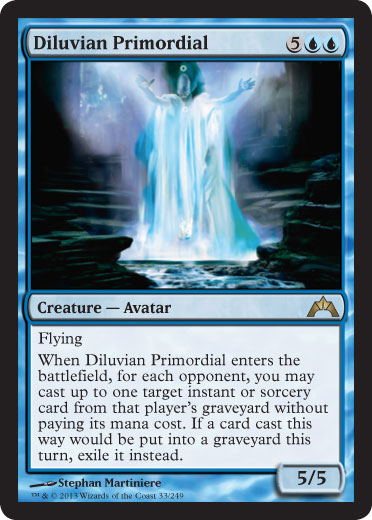Ancient floodwaters, dormant since the beginnings of the world, begin to stir. As they coalesce into a recognizable form, you understand the sweeping majesty of awakening powers—which are now at your command.
“For each opponent” is a phrase that Commander players love to hear, and they’re going to hear themselves say it frequently with Diluvian Primordial, gathering together the might of each of your opponents’ most powerful spells.
What Diluvian Primordial does is straightforward. When it enters the battlefield, you may cast an instant or sorcery from each opponent’s graveyard without paying its mana cost, while getting a 5/5 guy. It’s when we start examining the kinds of things that might happen that the card gets thoroughly exciting.
By the time you’re able to pay the seven mana to cast it, your opponents have all likely cast something cool already, whether it’s a simple ramp spell like Rampant Growth, a draw spell such as Harmonize (or even better, Gatecrash’s Urban Evolution), maybe a Tutor of some kind, or perhaps even something crazy like Storm Herd. Imagine using someone’s Swords to Plowshares to exile their own Avacyn, Angel of Hope. You’re unlikely to whiff on good targets because Commander is chock full of them. You’re going to have a more difficult time picking which awesome thing to cast than you are deciding if you want to cast this living flood of power.
When you put the triggered ability on the stack, you choose up to one target from each opponent’s graveyard. Then when it resolves, you play them in an order which you choose. This of course means you can arrange them for your best benefit. For example, if Player A has a great creature like Kokusho, the Evening Star in their graveyard, Player B has Beacon of Unrest, and Player C has Cloudshift, you can cast the Beacon of Unrest first, get Kokusho, and then keep it with Cloudshift. You might have a similar scenario with an in-play creature, but Player B has Act of Treason in their graveyard. Killing two birds with one stone, you get rid of a problematic creature and then strengthen up your own side.
If you want to be even trickier, you could use that Cloudshift to Blink Diluvian Primordial and start the madness all over again. The spells you cast are exiled afterward, so you can’t go into some infinite recursion loop, but the Primordial doing double-duty is reward enough already. You can pick off everyone’s cool utility spells for your own use and then make them unavailable for them to use against you later on. A dream scenario would be for one player to have a board sweeper like Damnation in their graveyard and another to have something that would save your guys—either Ghostway, which you’d play first, or Faith’s Reward, which you’d play after.
Getting further repeatable uses out of the Primordial is a direction you’d probably love to go. Deadeye Navigator can set you up for multiple uses. Since you’re in blue, you might want to consider Ghostly Flicker as a method of both protecting the Primordial and being able to reuse him when you might need to. Of course, blue will lend itself to copying it with the Clone family. You can also use Crystal Shard, Erratic Portal, Equilibrium, or the classic Man-o’-War to simply get Diluvian Primordial back into your hand to cast it again.
Now that we have an idea of the kinds of things we can do with Diluvian Primordial, how do we get there? The first answer that comes to mind is milling all your opponents so that you have many juicy choices. Cards like Mesmeric Orb and Mind Crank will get graveyards filled up pretty quickly, although you have to be on guard for reshufflers like Gaea’s Blessing and some of the Eldrazi. You can take slower mill routes like Millstone, Jace’s Erasure, Shriekgeist, Riddle Keeper, and Sewer Nemesis. You can also take further advantage of the soulbond mechanic with Stern Mentor.
If one of your opponents is playing that big control deck or anything with lots of instants and sorceries, Traumatize will give you a game’s full of choices to pick from out of their graveyard. You can also go a slower route with that player by way of Curse of the Bloody Tome or Memory Erosion. Moving into black, you get Extractor Demon, which can get out of hand very quickly, and, of course, a full suite of discard such as Painful Quandary, Hellhole Rats (which is also red), Ravenous Rats, and the ever-popular Syphon Mind. As with the vast possibilities of what you might be casting from everyone else’s graveyards, the number of ways you can get them there is great.
This Chaos-Embracing card will definitely be going into my The Mimeoplasm deck, which will also be getting other help from Gatecrash from both the Dimir and the Simic guilds. More on that in my set review and deck update articles in a few weeks. Until then, dream up ways that you’ll be making a big splash with the ancient flood.

